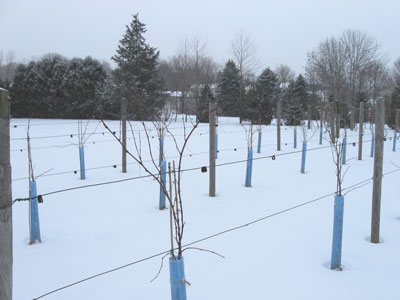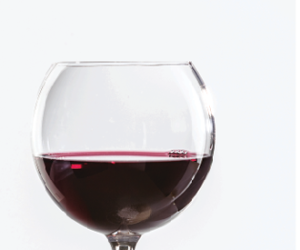 Even the most ideal climates for growing grapes face certain hardships, but growing vines in colder climates definitely have more than their share. Get tips on what to grow and what precautions to take from three pros in various colder climates.
Even the most ideal climates for growing grapes face certain hardships, but growing vines in colder climates definitely have more than their share. Get tips on what to grow and what precautions to take from three pros in various colder climates.
Winemaker: Coenraad Stassen, Brys Estate Vineyard and Winery, Traverse City, Michigan
There are just shy of 50 acres planted on our estate. We focus on European vinifera, including Cabernet Franc, Merlot, Pinot Noir, Riesling, Chardonnay, Pinot Blanc, Pinot Gris, and Gewürztraminer. The Old Mission Peninsula of Michigan does not have the longest track record when it comes to growing grapes, so in a sense we are still dialing in the varieties that work, in our climate. The most important aspect for me is finding vinifera varieties that can handle our winter temperatures well enough to produce a world class wine. We are focused on early to mid-season ripening varietals. Another factor is to find a nursery that can provide strong and healthy planting materials to ensure that you can see the vine through to maturity and producing premium grapes for wine production.
Each climate has its own unique challenges and for us it is no different. We are just bouncing back from back-to-back disaster vintages from 2014 and 2015. During the winter we saw temperatures plummet as low as -22 °F (-30 °C) with a wind chill much colder than that due to a Polar Vortex. We followed that up with a spring frost of 27 °F (-3 °C) after bud break. In August we had a storm system move through that was the biggest in over 100 years. We reached wind speeds of 95 mph accompanied by large hail. Rain fall amounts have also increased during late summer and early fall right before harvest. I think as the climate keeps changing, we will be facing spring frost more often due to the vines budding out earlier. All that said, when we do get a good vintage, it is something to experience. We are left with wines that express the soil and are packed with a punch of beautiful aromatics and fruit flavors and the perfect amount of acidity to create a mouthwatering and perfectly balanced wine.
Each fall after harvest, we select two to four canes and tie them to the irrigation wire. The reasoning behind this is that if we receive 18– 25 inches (46–64 cm) of base snow, the canes will be insulated. We also have a special snowplow that we put on the front of our tractor to cover the canes. The coldest temperatures occur during January and February. During that time I like to have some buried canes. For our area it is safe to anticipate a loss of around 1% of your total vines each year. We just finished our replants and we were around a total loss of 0.8%.
For me, trellising depends more on the varietal you grow as well as the winemaker’s input on the wines he or she will be producing than the climate. We use VSP (Vertical Shoot Position). It works well for the wines I produce.
We do not grow any hybrids on our property. I can see hybrids being a nice component as a blending varietal in years where you have a less-than-desirable growing season. However, I have yet to hear a convincing argument that proves you can compete in the upper tier market for fine wines with hybrids. I just don’t see the potential for building a following for such wines in that particular market. We have seen great success through vineyard management with our vinifera, but it is more site-specific. Maybe down the line we would need to experiment with other varietals, but for now we continue to keep the vinifera train going.
Winemaker: Aaron Peet, Cellardoor Winery, Lincolnville, Maine
When choosing what grapes to grow, cold hardiness and the ability to ripen to the right chemistry are the most important factors. To that end, we grow Marquette, Frontenac Blanc, Frontenac Gris, and L’Acadie Blanc. We feel that sparkling wine is the best way to embrace our short growing season and showcase the potential that Maine grapes can offer. We have high acidity in our grapes, which is perfect for sparkling wine. For example, L’Acadie Blanc came in last year at 19 °Brix, 3.08 pH, and 8.78 g/L TA. The Marquette and Frontenacs generally have higher acid, so we undergo full malolactic fermentation, but the flavor profiles are much more vinifera-like than many other hybrids so we love working with them.
We have three equal challenges associated with growing grapes in Maine – a short growing season, rain/humidity, and cold winters. Despite these challenges, the varieties we have planted are, for the most part, designed to handle these factors. We feel our sparkling wines are unique to the market and a refreshing alternative to those produced in warmer climates. For example, since the juice of the Marquette grape is uncommonly red, our sparkling rosé sees no skin contact and is pressed immediately straight from the field.
This process gives us both vibrant color and no resulting tannin. To help with the rain/humidity in our location, we employ cane pruning and VSP for greater air flow to help keep the clusters dry and free from mold.
While temperatures do get very cold in the winter, we have not had to provide additional winter protection for our vines. The Marquette and Frontenacs are extremely cold-hearty. The L’Acadie Blanc is newer to our vineyard and although it is a bit less cold-hearty, we have had good luck with it so far.
In addition to our sparkling wines from estate-grown grapes, we make table wines using grapes from Washington, California, and New York. Since there are so few acres of grape vines planted in Maine, we have chosen to seek out grapes from regions that inspire us. The majority of our grapes come from Washington State where I did my winemaking studies, and we then fill in the gaps with grapes from California and New York. Washington has some amazing vineyards with well-respected growers who are producing fantastic fruit. From their grapes, we have consistently made wines that win top awards at some of the nation’s most well-known competitions.
Winemaker: Gerald Klose, Inniskillin, Niagara, Ontario
We are located in the Niagara Peninsula, Canada, 10 kilometres (6 miles) north of Niagara Falls, between Lake Ontario and Lake Erie. This is a cool climate viticultural region, on the 43° N latitude – so it is a cool continental climate similar to Burgundy, France. We mainly grow Pinot Noir, Riesling, Chardonnay, Pinot Gris, Shiraz, and Gewürztraminer. As you can see, we mostly grow vitis vinifera grapes, however we do also produce a Baco Noir, which does very well here because it is hardy in the winter, it is uncomplicated to grow, and is an early ripening variety.
The biggest challenge in the Niagara Peninsula is the weather – we can have very cold winters with very hot summers, and then another year we can have very mild winters and very wet summers. The key to adapt to conditions on any given year is to manipulate the vines through pruning, shoot thinning, leaf removal, and hilling up the soil at the base trunk.
While our climate is cooler than that of many wine regions, we embrace the differences. For example, one year we can have a hot summer and our Shiraz will be more jammy in style. The next year, we might have a cooler summer and the same grapes will produce a Rhône-style wine.





